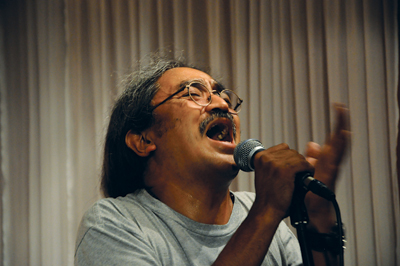This month, Nepalis will collectively celebrate two decades of Nepathya lending their voice to tell the ordinary Nepali’s stories
I remember how we would discover that a laahure had arrived in our village. It would be by the large transistor he would be carrying. The entire village would hear it. He’d play music we’d never heard before, bands like The Eagles and Led Zeppelin,” says Amrit Gurung.
When Nepathya performs on August 3 at London’s Wembley Arena, it becomes the first Nepali band to do so yes, but for Amrit, the band he’s led and kept alive for 24 odd years now also joins a league of bands whose posters once hung on his bedroom walls. It’s like a sweet dream he says, a warm smile spreading across his face. “It’s a celebration and I want Nepalis there to join us, by singing and dancing together, and making it something truly worth remembering,” he says.
 “Years ago, my friends and I were outside Wembley. I told them ‘maybe we’ll play here someday’. They laughed. I said ‘you never know, it could happen’,” he says, reminiscing of earlier days. For a band that Amrit says started out of boredom in their college days in Kathmandu, they’ve done pretty well. They are Nepal’s most popular band and their unique tours in Nepal –Nepathya’s “Shantiko laagi sikchha” (Education for peace) tour was timed during the Maoist insurgency period with an objective to spread the message of keeping schools free from the civil war – have won them fans not just in the cities but across the country. Since then they have toured the country with the same theme three more times and on numerous other tours too. Their concerts abroad have also taken them to Nepalis living far from home, in less than usual places like Tel Aviv even.
“Years ago, my friends and I were outside Wembley. I told them ‘maybe we’ll play here someday’. They laughed. I said ‘you never know, it could happen’,” he says, reminiscing of earlier days. For a band that Amrit says started out of boredom in their college days in Kathmandu, they’ve done pretty well. They are Nepal’s most popular band and their unique tours in Nepal –Nepathya’s “Shantiko laagi sikchha” (Education for peace) tour was timed during the Maoist insurgency period with an objective to spread the message of keeping schools free from the civil war – have won them fans not just in the cities but across the country. Since then they have toured the country with the same theme three more times and on numerous other tours too. Their concerts abroad have also taken them to Nepalis living far from home, in less than usual places like Tel Aviv even.
Their distinct folk sound wasn’t planned either. Amrit started off listening to heavy metal and hard rock, different from the rural sounds his songs echo so beautifully. “For rock music, we would have needed instruments and a better sense of that culture. We never gravitated toward that. We’d either have had to do covers but there isn’t much joy in that. It’s a momentary thing that doesn’t have any lasting impact. And so our sound grew into a folksy Nepali sound.” To refine this sound, it would be more than fair to say that the band or rather Amrit Gurung – for the band’s original line-up has seen more than 20 faces come and go – has done his homework.
 Amrit has walked, yes actually walked to 73 out of 75 of Nepal’s districts; he only counts having been to a place if he’s walked there. And from every place, every sight he’s seen in Nepal’s countryside, he brings back melodies and tunes that he weaves into folk pop that his fans enjoy the world over. “Energy bhai, I bring back energy from my journey. And I bring back what I have experienced, my conversations with strangers and the sights I have seen. These trips charge me.”
Amrit has walked, yes actually walked to 73 out of 75 of Nepal’s districts; he only counts having been to a place if he’s walked there. And from every place, every sight he’s seen in Nepal’s countryside, he brings back melodies and tunes that he weaves into folk pop that his fans enjoy the world over. “Energy bhai, I bring back energy from my journey. And I bring back what I have experienced, my conversations with strangers and the sights I have seen. These trips charge me.”
Predictably, he doesn’t like noisy place. Where birds are chirping, the Himalayas are in clear sight, flowers are in bloom, children are playing, streams flowing – that’s where he loves being. “I don’t feel like I have to find something from my travels though. There’s no process to finding music. The easiest is when you find people singing at certain ceremonies like marriages or rituals. Sometimes you go for weeks without finding anything. And sometimes you’re walking through a forest, lost in thought, and you hear someone singing; that’s how I have composed some of my songs. Imagine crossing a pass at 4000 metres, and coming across a stranger singing a sweet song. How fun is that? The only process you can ensure is that you actually go there.”
When talk turns to his war-time tours, his voice has an edge, of frustration and of resolve. “We’re a failed generation but our children are the future. The idea was to request all sides to keep schools free of war. Students were taken for ‘training’ and teachers disappeared. Cinemas closed and festivals and celebrations stopped happening. And Nepal used to have so many more festivals. But entertainment is a human right and that’s why we went. We were scared then. But now I feel good that we did something important,” he says. It’s clear that Amrit feels strongly about the role education plays in shaping the country. “Our education has to be strong. People are guided by their thoughts.”
This passion is reflected in his stage shows, where the usually calm and composed Amrit becomes an animated character, jumping around, and singing from his guts. Is this the same Amrit Gurung? “It’s not like singing alone in a room. Singing to thousands, with those lights, that sound, my band, and these people who have come despite so many different circumstances. Those vibrations are different; it’s a drug. The audience can only enjoy it if I do,” he answers.
 Amrit has always used this platform for more than music. Nepathya’s music plays a role of social advocacy through music. “I have always been a very social person. When my village needed a road, we performed, raised money and constructed a road. I have always had that sense. We were always involved with social work. Maybe it due to the circumstances the country was in. We started with romantic songs. As the country changed, we felt a social responsibility.”
Amrit has always used this platform for more than music. Nepathya’s music plays a role of social advocacy through music. “I have always been a very social person. When my village needed a road, we performed, raised money and constructed a road. I have always had that sense. We were always involved with social work. Maybe it due to the circumstances the country was in. We started with romantic songs. As the country changed, we felt a social responsibility.”
For someone who’s traveled like this, far and wide in the countryand also abroad, he possibly might be one Nepali who’s met the most number of other Nepalis worldwide I offer. What three common traits does a Nepali have? “Nepali people are very open hearted, once you know each other, whether it is abroad or in Nepal. Second, Nepalis love it when they hear you speak their language. It’ll get you food and shelter, whether it’s at a Bahun’s home or a Gurung’s. Thirdly, when Nepalis recognize you as a Nepali, they’ll try to make themselves known. This is what I have experienced,” he says adding, “I don’t like it when people talk nonsense about Nepali music and artists and people without understanding things. That’s my weakness. Besides that, like they say, bhanchha ma basey pachhi bhada haru thokinchhan (if you stay in the kitchen, your utensils will clash).”
After the interview, we follow Amrit downstairs, to Nepathya’s practise room in Nepa~laya’s office in Kalikasthan. He switches gears immediately and as I watch him sing, it’s like watching the words he uttered to me brought to life. To watch Amrit Gurung sing is to watch him reminisce about every hill he’s stepped on, every stream he’s crossed and every possibility he’s seen for Nepal. It’s to see the country through his eyes.
To hear him sing is to hear the voice of every stranger he’s met in a half empty village, every child he’s laughed with and every woman he’s asked for shelter. To watch him jump like a teenager is to feel the energy of Nepali youth and possibility rush through him, the space and through you. It’s almost like every person he’s met in his travels is singing through him, telling their own stories through the voice of the most recognizable, most popular face of Nepali music worldwide. And it’s only important that he take these stories to the world – who better than Nepathya to do it.










